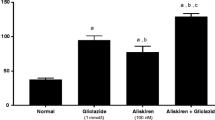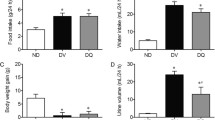Abstract
Purpose
To investigate the protective effect of vanillic acid (VA) in streptozotocin (STZ)-induced diabetic nephropathy (DN) in rats.
Methods
Experimental diabetes mellitus in rats was induced by intraperitoneally administration of single dose of STZ (55 mg/kg). The animals were divided into 5 groups viz., normal control, diabetic control, glimepiride (0.5 mg/kg, orally) and VA treatment (50 and 100 mg/kg, orally) groups. The treatment was started after the confirmation of hyperglycemia (> 250 mg/dl) and continued for 6 weeks. Serum glucose level, and body weight were measured weekly. At the end of study, HbA1c in whole blood, insulin, lipid profile, urea, creatinine and albumin in serum. Creatinine and albumin were measured in urine along with creatinine clearance. In addition, kidney weight and histopathology were assessed.
Results
Treatment with VA markedly attenuated STZ-induced body weight loss and hyperglycemia, along with improved lipid profile and HbA1c, without significant alteration of serum insulin levels. It also decreased urea, creatinine and increased albumin in serum. Moreover, VA, significantly reduced urine volume, urinary albumin along with marked improvement in creatinine clearance. Further, the VA treatment significantly reverse the raised levels of oxidative stress markers, pro-inflammatory and fibrotic markers viz. TNF-α, IL-1β, IL-6, TGF-β1 and NFκB activity in kidney tissue. These effects are associated with amelioration of histopathological alterations compared to diabetic control rats. While glimepiride produced similar antihyperglycemic effect but the effect on albuminuria, oxidative stress markers and cytokine levels were less significant as compared to VA (100 mg/kg).
Conclusions
In conclusion, VA exhibited nephroprotective effect through amelioration of kidney dysfunction and damage in diabetic rats. The observed nephroprotective effect of VA may be ascribed to inhibition of hyperglycemia induced oxido-inflammatory stress and necroptosis of renal tissue possibly due to its antihyperglycemic, antioxidant and anti-inflammatory actions.



Similar content being viewed by others
References
International Diabetes Federation. IDF. Diabetes Atlas. 9th ed. 2019. http://www.idf.org/diabetesatlas.
Forbes JM, Cooper ME. Mechanisms of diabetic complications. Physiol Rev. 2013;93:137–88.
Donate-Correa J, Luis-Rodriguez D, Martin-Nunez E, Tagua VG, Hernandez-Carballo C, Ferri C. Inflammatory targets in diabetic nephropathy. J Clin Med. 2020;9:458. https://doi.org/10.3390/jcm9020458.
Varghese RT, Jialal I. Diabetic Nephropathy. :Treasure Island: StatPearls Publishing LLC. 2020, https://www.ncbi.nlm.nih.gov/books/NBK534200/.
Zhu L, Han J, Yuan R, Xue L, Pang W. Berberine ameliorates diabetic nephropathy by inhibiting TLR4/NF-κB pathway. Biol Res. 2018;51:9. https://doi.org/10.1186/s40659-018-0157-8.
Toth-Manikowski S, Mohamed GA. Diabetic kidney disease: pathophysiology and therapeutic targets. J Diabetes Res. 2015. https://doi.org/10.1155/2015/697010.
Powers AC. Diabetes mellitus-mechanisms of complications. In: Kasper DL, Braunwald E, Anthony S, Stephen L, Dan L, Larry J, editors. Text Book of Harrison’s Principles of Internal Medicine. 16th ed. Vol. II. New York: McGraw-Hill Medical Publishing Division; 2020. p. 2164.
Mogensen CE, Christensen CK, Vittinghus E. The stages in diabetic renal disease. With emphasis on the stage of incipient diabeticnephropathy. Diabetes. 1983;32:64–78.
Ilyas Z, Chaiban JT, Krikorian A. Novel insights into the pathophysiology and clinical aspects of diabetic nephropathy. Rev EndocrMetabDisord. 2017;18:21–8.
Navarro-Gonzalez JF, Mora-Fernandez C. The role of inflammatory cytokines in diabetic nephropathy. J Am Soc Nephrol. 2008;19:433–42.
Malik S, Suchal K, Khan SI, Bhatia J, Kishore K, Dinda AK. Apigenin ameliorates streptozotocin-induced diabetic nephropathy in rats via MAPK-NF-κB-TNF-α and TGF-β1-MAPK-fibronectin pathways. Am J Physiol Renal Physio. 2017;313:414–22.
Foggensteiner L, Mulroy S, Firth J. Management of diabetic nephropathy. J R Soc Med. 2001;94:210–17.
Tabatabaei-Malazy O, Larijani B, Abdollahi M. Targeting metabolic disorders by natural products. J Diabetes Metab Disord. 2015;14:57. https://doi.org/10.1186/s40200-015-0184-8.
Aryaeian N, Sedehi SK, Arablou T. Polyphenols and their effects on diabetes management: A review. Med J Islam Repub Iran. 2017;31:134. https://doi.org/10.14196/mjiri.31.134.
Almeida IV, Cavalcante FM, Vicentini VE. Different responses of vanillic acid, a phenolic compound, in HTC cells: cytotoxicity, antiproliferative activity, and protection from DNA-induced damage. Genet Mol Res. 2016;15:4. https://doi.org/10.4238/gmr15049388.
Itoh A, Isoda K, Kondoh M, Kawase M, Watari A, Kobayashi M, et al. Effect of syringic acid and vanillic acid on CCl4 induced liver injury. Biol Pharm Bull. 2010;33:983–7.
Bernal-Mercado AT, Gutierrez-Pacheco MM, Encinas-Basurto D, Mata-Haro V, Lopez-Zavala AA, Islas-Osuna MA, et al. Synergistic mode of action of Catechin, Vanillic and Protocatechuic acids to inhibit the adhesion of uropathogenic Escherichia Coli on silicone surfaces. J Appl Microbiol. 2020;128:387–400.
Kumar S, Prahalathan P, Raja B. Antihypertensive and antioxidant potential of vanillic acid, a phenolic compound in L-NAME-induced hypertensive rats: a dose dependence study. Redox Rep. 2011;16:208–15.
Ji G, Sun R, Hu H, Xu F, Yu X, Veeraraghavan VP, et al. Vannilic acid ameliorates hyperglycemia-induced oxidative stress and inflammation in streptozotocin-induced diabetic rats. J King Saud Univ – Sci. 2020. Availabe from: https://doi.org/10.1016/j.jksus.2020.04.010.
Chang WC, Wu JS, Chen CW, Kuo PL, Chien HM, Wang YT, et al. Protective effect of vanillic acid against hyperinsulinemia, hyperglycemia and hyperlipidemia via alleviating hepatic insulin resistance and inflammation in High-Fat Diet (HFD)-Fed Rats. Nutrients. 2015;7:9946–59.
Vinothiya K, Ashokkumar N. Modulatory effect of vanillic acid on antioxidant status in high fat diet-induced changes in diabetic hypertensive rats. Biomed Pharmacother. 2017;87:640–52.
Alim Z, Kilinç N, Şengül B, Beydemir S. Inhibition behaviours of some phenolic acids on rat kidney aldose reductase enzyme: an in vitro study. J Enzyme Inhib Med Chem. 2017;32:277–84.
Sindhu G, Nishanthi E, Sharmila R. Nephroprotective effect of vanillic acid against cisplatin induced nephrotoxicity in wistar rats: a biochemical and molecular study. Environ Toxicol Pharmacol. 2015;39:392–404.
Kim M, Kim S, Kim D, Jeon Y, Park SJ, Lee HS, et al. Vanillic acid inhibits inflammatory mediators by suppressing NF-κB in lipopolysaccharide-stimulated mouse peritoneal macrophages. Immunopharmacol Immunotoxicol. 2011;33:525–32.
Dubey VK, Patil CR, Kamble SM, Tidke PS, Patil KR, Maniya PJ, et al. Oleanolic acid prevents progression of streptozotocin induced diabetic nephropathy and protects renal microstructures in Sprague Dawley rats. J Pharmacol Pharmacother. 2013;4:47–52.
Tripathi AS, Mazumder PM, Chandewar AV. Sildenafil, a phosphodiesterase type 5 inhibitor, attenuates diabetic nephropathy in STZ-induced diabetic rats. J Basic Clin Physiol Pharmacol. 2016;27:57–62.
Parasuraman S, Raveendran R, Kesavan R. Blood sample collection in small laboratory animals. J Pharmacol Pharmacother. 2010;1:87–93.
Eren Z, Gunal MY, Bakir EA, Coban J, Çağlayan B, Ekimci N, et al. Effects of paricalcitol and aliskiren combination therapy on experimental diabetic nephropathy model in rats. Kidney Blood Press Res. 2014;39:581–90.
Mestry SN, Dhodi JB, Kumbhar SB, Juvekar AR. Attenuation of diabetic nephropathy in streptozotocin-induced diabetic rats by Punica granatum Linn. leaves extract. J Tradit Complement Med. 2016;7:273–80.
Ohkawa H, Ohishi N, Yagi K. Assay for lipid peroxides in animal tissues by thiobarbituric acid reaction. Anal Biochem. 1979;95:351–8.
Misra HP, Fridovich I. The role of superoxide anion in the autoxidation of epinephrine and a simple assay for superoxide dismutase. J Biol Chem. 1972;247:3170–5.
Sinha AK. Colorimetric assay of catalase. Anal Biochem. 1972;47:389–94.
Ellman GL. Tissue sulfhydryl groups. Arch Biochem Biophys. 1959;82:70–7.
Pelley JW, Garner CW, Little GH. A simple rapid biuret method for the estimation of protein in samples containing thiols. Anal Biochem. 1978;86:341–3.
Cheng D, Liang B, Li Y. Antihyperglycemic effect of Ginkgo biloba extract in streptozotocin-induced diabetes in rats. Biomed Res Int. 2013. https://doi.org/10.1155/2013/162724.
Papadopoulou-Marketou N, Kanaka-Gantenbein C, Marketos N, Chrousos GP, Papassotiriou I. Biomarkers of diabetic nephropathy: A 2017 update. Crit Rev Clin Lab Sci. 2017;54:326–42.
Kolset SO, Reinholt FP, Jenssen T. Diabetic nephropathy and extracellular matrix. J Histochem Cytochem. 2012;60:976–86.
Nakagawa T, Sato W, Glushakova O, Heinig M, Clarke T, Campbell-Thompson M, et al. Diabetic endothelial nitric oxide synthase knockout mice develop advanced diabetic nephropathy. J Am Soc Nephrol. 2007;18:539–50.
King GL, Loeken MR. Hyperglycemia-induced oxidative stress in diabetic complications. Histochem Cell Biol. 2004;122:333–8.
Suryavanshi SV, Kulkarni YA. NF-κβ: a potential target in the management of vascular complications of diabetes. Front Pharmacol. 2017;8:798. https://doi.org/10.3389/fphar.2017.00798.
Ahmed S, Mundhe N, Borgohain M, Chowdhury L, Kwatra M, Bolshette N, et al. Diosmin modulates the NF-kB signal transduction pathways and downregulation of various oxidative stress markers in alloxan-induced diabetic nephropathy. Inflammation. 2016;39:1783–97.
Sun L, Kanwar YS. Relevance of TNF-α in the context of other inflammatory cytokines in the progression of diabetic nephropathy. Kidney Int. 2015;88:662–5.
Navarro-Gonzalez JF, Mora-Fernandez C, Muros de Fuentes M, Garcia-Perez J. Inflammatory molecules and pathways in the pathogenesis of diabetic nephropathy. Nat Rev Nephrol. 2011;7:327–40.
Salti T, Khazim K, Haddad R, Campisi-Pinto S, Bar-Sela G, Cohen I. Glucose induces IL-1α-dependent inflammation and extracellular matrix proteins expression and deposition in renal tubular epithelial cells in diabetic kidney disease. Front Immunol. 2020;11:1270. https://doi.org/10.3389/fimmu.2020.01270.
Dinarello CA, Simon A, van der Meer JW. Treating inflammation by blocking interleukin-1 in a broad spectrum of diseases. Nat Rev Drug Disc. 2012;11:633–52.
Anders HJ. Of inflammasomes and alarmins: IL-1β and IL-1α in kidney disease. J Am Soc Nephrol. 2016;27:2564–75.
Buraczynska M, Ksiazek P, Baranowicz-Gaszczyk I, Jozwiak L. Association of the VEGF gene polymorphism with diabetic retinopathy in type 2 diabetes patients. Nephrol Dial Transplant. 2007;22:827–32.
Lei Y, Devarapu SK, Motrapu M, Cohen CD, Lindenmeyer MT, Moll S, Kumar SV, Anders HJ. Interleukin-1β inhibition for chronic kidney disease in obese mice with type 2 diabetes. Front Immunol. 2019;10:1223. https://doi.org/10.3389/fimmu.2019.01223.
Donate-Correa J, Martín-Núñez E, Muros-de-Fuentes M, Mora-Fernández C, Navarro-González JF. Inflammatory cytokines in diabetic nephropathy. J Diabetes Res. 2015. https://doi.org/10.1155/2015/948417.
Zabad OM, Samra YA, Eissa LA. P-Coumaric acid alleviates experimental diabetic nephropathy through modulation of Toll like receptor-4 in rats. Life Sci. 2019. https://doi.org/10.1016/j.lfs.2019.116965.
Zhou B, Li Q, Wang J, Chen P, Jiang S. Ellagic acid attenuates streptozocin induced diabetic nephropathy via the regulation of oxidative stress and inflammatory signaling. Food Chem Toxicol. 2019;123:16–27.
Zeng LF, Xiao Y, Sun L. A glimpse of the mechanisms related to renal fibrosis in diabetic nephropathy. Adv Exp Med Biol. 2019;1165:49–79.
Hu C, Sun L, Xiao L, Han Y, Fu X, Xiong X, et al. Insights into the mechanisms involved in the expression and regulation of extracellular matrix proteins in diabetic nephropathy. Curr Med Chem. 2015;22:2858–70.
Lee HB, Yu MR, Yang Y, Jiang Z, Ha H. Reactive oxygen species-regulated signaling pathways in diabetic nephropathy. J Am Soc Nephrol. 2003;14:241-5.
Chen S, Jim B, Ziyadeh FN. Diabetic nephropathy and transforming growth factor-beta: transforming our view of glomerulosclerosis and fibrosis build-up. Semin Nephrol. 2003;23:532–43.
Farris AB, Alpers CE. What is the best way to measure renal fibrosis? A pathologist’s perspective. Kidney Int Suppl. 2014;4:9–15.
Acknowledgements
The authors are thankful to the Chairman, CT Group of Institutions, Jalandhar, Director, CT Institute of Pharmaceutical Sciences, Jalandhar and IKG- PTU (Punjab Technical University), Jalandhar, Kapurthala, India for providing necessary facilities to complete the research work.
Author information
Authors and Affiliations
Corresponding author
Ethics declarations
Animal ethics
Animals used for experiments were acclimatized for 10 days before starting the study. They received humane care, standard pellet chow, purified water ad libitum and were maintained under controlled environmental conditions of temperature (22 ± 3 °C) and relative humidity (55 ± 5 %) under 12 h light/dark cycle. The experimental protocol [Proposal No. IAEC-CTIPS/2019/XI/0070(PCL-D)] was approved by the Institutional Animal Ethical Committee and the experiments were performed in accordance with use and care guidelines prescribed by the Committee for the purpose of control and supervision of experiments on animals (CPCSEA), Government of India.
Conflict of interest
The authors declare no conflicts of interest.
Additional information
Publisher’s note
Springer Nature remains neutral with regard to jurisdictional claims in published maps and institutional affiliations.
Rights and permissions
About this article
Cite this article
Kumari, S., Kamboj, A., Wanjari, M. et al. Nephroprotective effect of Vanillic acid in STZ-induced diabetic rats. J Diabetes Metab Disord 20, 571–582 (2021). https://doi.org/10.1007/s40200-021-00782-7
Received:
Accepted:
Published:
Issue Date:
DOI: https://doi.org/10.1007/s40200-021-00782-7




